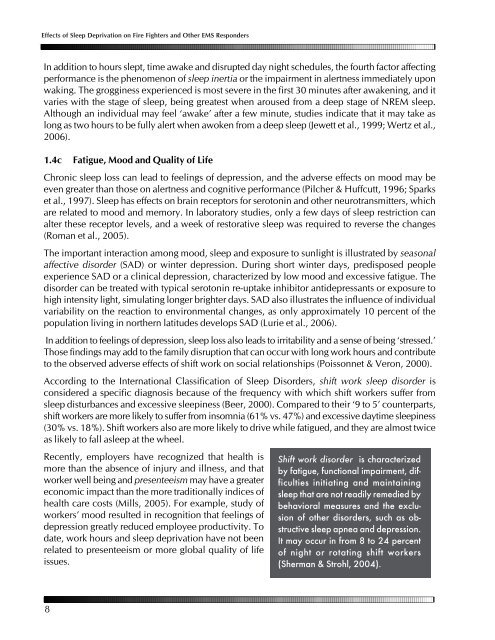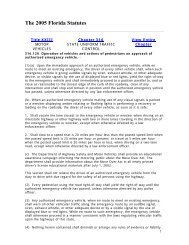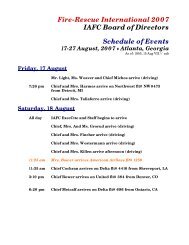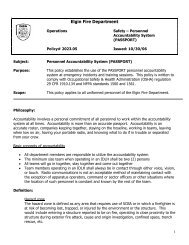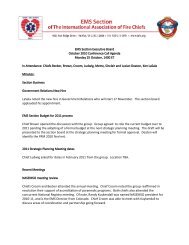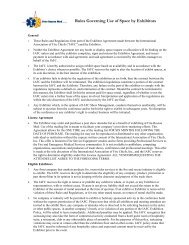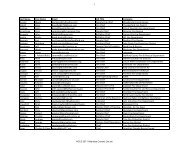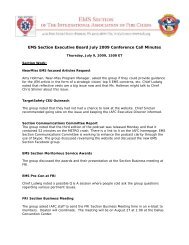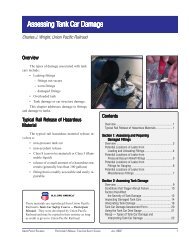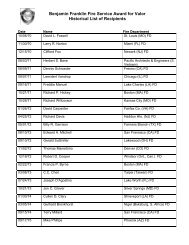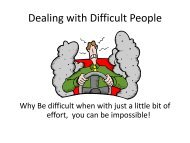Effects of Sleep Deprivation on Fire Fighters and EMS ... - NAEMT
Effects of Sleep Deprivation on Fire Fighters and EMS ... - NAEMT
Effects of Sleep Deprivation on Fire Fighters and EMS ... - NAEMT
You also want an ePaper? Increase the reach of your titles
YUMPU automatically turns print PDFs into web optimized ePapers that Google loves.
<str<strong>on</strong>g>Effects</str<strong>on</strong>g> <str<strong>on</strong>g>of</str<strong>on</strong>g> <str<strong>on</strong>g>Sleep</str<strong>on</strong>g> <str<strong>on</strong>g>Deprivati<strong>on</strong></str<strong>on</strong>g> <strong>on</strong> <strong>Fire</strong> <strong>Fighters</strong> <strong>and</strong> Other <strong>EMS</strong> Resp<strong>on</strong>ders<br />
In additi<strong>on</strong> to hours slept, time awake <strong>and</strong> disrupted day night schedules, the fourth factor affecting<br />
performance is the phenomen<strong>on</strong> <str<strong>on</strong>g>of</str<strong>on</strong>g> sleep inertia or the impairment in alertness immediately up<strong>on</strong><br />
waking. The grogginess experienced is most severe in the first 30 minutes after awakening, <strong>and</strong> it<br />
varies with the stage <str<strong>on</strong>g>of</str<strong>on</strong>g> sleep, being greatest when aroused from a deep stage <str<strong>on</strong>g>of</str<strong>on</strong>g> NREM sleep.<br />
Although an individual may feel ‘awake’ after a few minute, studies indicate that it may take as<br />
l<strong>on</strong>g as two hours to be fully alert when awoken from a deep sleep (Jewett et al., 1999; Wertz et al.,<br />
2006).<br />
1.4c Fatigue, Mood <strong>and</strong> Quality <str<strong>on</strong>g>of</str<strong>on</strong>g> Life<br />
Chr<strong>on</strong>ic sleep loss can lead to feelings <str<strong>on</strong>g>of</str<strong>on</strong>g> depressi<strong>on</strong>, <strong>and</strong> the adverse effects <strong>on</strong> mood may be<br />
even greater than those <strong>on</strong> alertness <strong>and</strong> cognitive performance (Pilcher & Huffcutt, 1996; Sparks<br />
et al., 1997). <str<strong>on</strong>g>Sleep</str<strong>on</strong>g> has effects <strong>on</strong> brain receptors for serot<strong>on</strong>in <strong>and</strong> other neurotransmitters, which<br />
are related to mood <strong>and</strong> memory. In laboratory studies, <strong>on</strong>ly a few days <str<strong>on</strong>g>of</str<strong>on</strong>g> sleep restricti<strong>on</strong> can<br />
alter these receptor levels, <strong>and</strong> a week <str<strong>on</strong>g>of</str<strong>on</strong>g> restorative sleep was required to reverse the changes<br />
(Roman et al., 2005).<br />
The important interacti<strong>on</strong> am<strong>on</strong>g mood, sleep <strong>and</strong> exposure to sunlight is illustrated by seas<strong>on</strong>al<br />
affective disorder (SAD) or winter depressi<strong>on</strong>. During short winter days, predisposed people<br />
experience SAD or a clinical depressi<strong>on</strong>, characterized by low mood <strong>and</strong> excessive fatigue. The<br />
disorder can be treated with typical serot<strong>on</strong>in re-uptake inhibitor antidepressants or exposure to<br />
high intensity light, simulating l<strong>on</strong>ger brighter days. SAD also illustrates the influence <str<strong>on</strong>g>of</str<strong>on</strong>g> individual<br />
variability <strong>on</strong> the reacti<strong>on</strong> to envir<strong>on</strong>mental changes, as <strong>on</strong>ly approximately 10 percent <str<strong>on</strong>g>of</str<strong>on</strong>g> the<br />
populati<strong>on</strong> living in northern latitudes develops SAD (Lurie et al., 2006).<br />
In additi<strong>on</strong> to feelings <str<strong>on</strong>g>of</str<strong>on</strong>g> depressi<strong>on</strong>, sleep loss also leads to irritability <strong>and</strong> a sense <str<strong>on</strong>g>of</str<strong>on</strong>g> being ‘stressed.’<br />
Those findings may add to the family disrupti<strong>on</strong> that can occur with l<strong>on</strong>g work hours <strong>and</strong> c<strong>on</strong>tribute<br />
to the observed adverse effects <str<strong>on</strong>g>of</str<strong>on</strong>g> shift work <strong>on</strong> social relati<strong>on</strong>ships (Poiss<strong>on</strong>net & Ver<strong>on</strong>, 2000).<br />
According to the Internati<strong>on</strong>al Classificati<strong>on</strong> <str<strong>on</strong>g>of</str<strong>on</strong>g> <str<strong>on</strong>g>Sleep</str<strong>on</strong>g> Disorders, shift work sleep disorder is<br />
c<strong>on</strong>sidered a specific diagnosis because <str<strong>on</strong>g>of</str<strong>on</strong>g> the frequency with which shift workers suffer from<br />
sleep disturbances <strong>and</strong> excessive sleepiness (Beer, 2000). Compared to their ‘9 to 5’ counterparts,<br />
shift workers are more likely to suffer from insomnia (61% vs. 47%) <strong>and</strong> excessive daytime sleepiness<br />
(30% vs. 18%). Shift workers also are more likely to drive while fatigued, <strong>and</strong> they are almost twice<br />
as likely to fall asleep at the wheel.<br />
Recently, employers have recognized that health is<br />
more than the absence <str<strong>on</strong>g>of</str<strong>on</strong>g> injury <strong>and</strong> illness, <strong>and</strong> that<br />
worker well being <strong>and</strong> presenteeism may have a greater<br />
ec<strong>on</strong>omic impact than the more traditi<strong>on</strong>ally indices <str<strong>on</strong>g>of</str<strong>on</strong>g><br />
health care costs (Mills, 2005). For example, study <str<strong>on</strong>g>of</str<strong>on</strong>g><br />
workers’ mood resulted in recogniti<strong>on</strong> that feelings <str<strong>on</strong>g>of</str<strong>on</strong>g><br />
depressi<strong>on</strong> greatly reduced employee productivity. To<br />
date, work hours <strong>and</strong> sleep deprivati<strong>on</strong> have not been<br />
related to presenteeism or more global quality <str<strong>on</strong>g>of</str<strong>on</strong>g> life<br />
issues.<br />
Shift work disorder is characterized<br />
by fatigue, functi<strong>on</strong>al impairment, difficulties<br />
initiating <strong>and</strong> maintaining<br />
sleep that are not readily remedied by<br />
behavioral measures <strong>and</strong> the exclusi<strong>on</strong><br />
<str<strong>on</strong>g>of</str<strong>on</strong>g> other disorders, such as obstructive<br />
sleep apnea <strong>and</strong> depressi<strong>on</strong>.<br />
It may occur in from 8 to 24 percent<br />
<str<strong>on</strong>g>of</str<strong>on</strong>g> night or rotating shift workers<br />
(Sherman & Strohl, 2004).<br />
8


